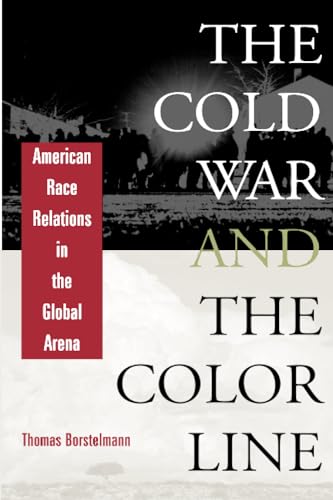The Cold War and the Color Line: American Race Relations in the Global Arena


sku: COM9780674012387USED
ACCORDING TO OUR RECORDS THIS PRODUCT IS NOT AVAILABLE NOW
$6.20
Shipping from: Canada
Description
After World War II the United States faced two preeminent challenges: how to administer its responsibilities abroad as the world's strongest power, and how to manage the rising movement at home for racial justice and civil rights. The effort to contain the growing influence of the Soviet Union resulted in the Cold War, a conflict that emphasized the American commitment to freedom. The absence of that freedom for nonwhite American citizens confronted the nation's leaders with an embarrassing contradiction. Racial discrimination after 1945 was a foreign as well as a domestic problem. World War II opened the door to both the U.S. civil rights movement and the struggle of Asians and Africans abroad for independence from colonial rule. America's closest allies against the Soviet Union, however, were colonial powers whose interests had to be balanced against those of the emerging independent Third World in a multiracial, anticommunist alliance. At the same time, U.S. racial reform was essential to preserve the domestic consensus needed to sustain the Cold War struggle.The Cold War and the Color Line is the first comprehensive examination of how the Cold War intersected with the final destruction of global white supremacy. Thomas Borstelmann pays close attention to the two Souths--Southern Africa and the American South--as the primary sites of white authority's last stand. He reveals America's efforts to contain the racial polarization that threatened to unravel the anticommunist western alliance. In so doing, he recasts the history of American race relations in its true international context, one that is meaningful and relevant for our own era of globalization.
Price history chart & currency exchange rate
Customers also viewed

$4.67
Mother's Day Baby Bodysuit Infant Rompers Boys Girls Clothes Toddler Newbron Outfits Mothers Day Gift Baby Short Sleeve Romper
aliexpress.com
$1.66
Aluminum Alloy 25T Steering Servo Arm Horn Special Designed For 30-100CC Balsa Airplanes
aliexpress.com
$0.68
Sanrio Cinnamoroll, карманная маленькая сумка на шнурке с мультяшным рисунком, женская косметичка, Портативная сумка для туалетных принадлежностей
aliexpress.ru
$3.69
1 шт. сверхмощный Магнитный выдвижной брелок для ключей, легко вытягивающаяся Пряжка для улицы
aliexpress.ru
$1.70
Корректор для вросшего ногтя, инструмент для педикюра, Восстанавливающее Средство для лечения Ногтей, профессиональный инструмент для коррекции вросшего ногтя, инструмент для ухода за ногами
aliexpress.ru
$15.56
USB C к аудиоадаптеру 3,5 мм, сплиттер для наушников 3 в 1 Aux к USB C, совместим с iPad Pro,Galaxy S22 S21 S20/Note 20,Pixel 4 3
aliexpress.ru
$20.69
Новинка, свадебный букет для невесты, женская модель, свадебные принадлежности, праздничные украшения, аксессуар
aliexpress.ru
$18.25
RGB-ретранслятор мощности, фотоконтроллер лампы 3000 В, оптоэлектронная изоляция, постоянный ток 5-24 В, 5 А * 3 канала, 8 А * 3 канала, фоторегулятор
aliexpress.ru
$23.97
Sen Department Green Creative Square candy box wedding favor chocolate box party supplies box christmas gift box baby shower
aliexpress.com
$181.97
Электрическая плита, Топ 30 дюймов, 4 горелки, электрическая варочная панель, 9 уровней мощности и сенсорное управление, легко моется, керамическое стекло для серфинга
aliexpress.ru
$26.50
Полка-органайзер для ванной комнаты, стойка для хранения душа, черные угловые полки, Настенный алюминиевый держатель для шампуня, без сверления
aliexpress.ru
$181.21
Электрический беспроводной пистолет для герметизации, портативный пистолет для герметизации стекла и твердой резины, ручной перезаряжаемый клеевой пистолет с батареей, мягкий клеевой пистолет
aliexpress.ru
$53.74
Аксессуары для медленной плиты, контейнер 11 л + стойка из нержавеющей стали, съемные разделители, сепаратор для большинства машин для приготовления под вакуумом
aliexpress.ru
$9.86
Черная Девушка меланин, Волшебная черная история месяца, Афро Королева, афроцентрическая рубашка, футболка, модная забавная новая модель
aliexpress.ru
$0.97
5 шт./лот BP2833D BP2833 DIP-8 светодиодный драйвер постоянного тока чип в наличии новый оригинальный IC
aliexpress.ru
$0.77
Спортивная повязка на голову унисекс, эластичная повязка на голову для бега, езды на велосипеде, йоги, баскетбола, Влагоотводящая повязка для волос
aliexpress.ru
$22.57
5 м Новинка для кухни домашний декор 80 см Широкий мрамор виниловые самоклеящиеся обои декоративная пленка контактная бумага настенные наклейки 2023
aliexpress.ru
$12.87
Детские туфли принцессы с жемчужным бантом для девочек, черные, белые кожаные туфли, Детская удобная обувь на одной мягкой подошве
aliexpress.ru
$3.58
URPRETTY 925 Sterling Silver Fireworks Chain Bracelet For Women Party Wedding Engagement Charm Jewelry
aliexpress.ru
$10.69
2020 Fashion Woman Shoulder Bag Nylon Waterproof FlapVersatile Black Zipper Travel Handbag Bolsa Feminina Sac Purses Crossbody
aliexpress.com
$11.68
Гирлянда бумажная флажки ZavodDekor "Мексика" 5 метров (24 флажков) Разноцветная
rozetka.com.ua
$12.00
Colorful triangular tunnel moving into the distance, neon geometric background, abstract 3D background with spectral metal glow, long tunnel
creativemarket.com
$49.13
Men' Hoodies Jumeast Men/women Fashion 3D Sweatshirts Print Galaxy Dog Whirlpool Nebula Thin Hooded Unisex Hoody Pullovers
dhgate.com
$39.83
Marc Tote Bag Designer Handbag Women New Large Capacity Canvadesigner Bagshoulder Casual Simple Shopping Messenger Crossbody s 220609, Navy blue
dhgate.com
$13.63
3C0906093C Gasoline Pump Controller Fuel Pump Controller For VW Magotan Sagitar Golf 6 Tiguan 3C0 906 093 C
aliexpress.com
$38.54
Датчик давления в шинах автомобиля TPMS 4260708010, 4 шт., для TOYOTA SEQUOIA SIENNA, TUNDRA 42607-08010
aliexpress.ru
$31.32
Набор запасных ключей зажигания для Pajero замок для перчаточного ящика для Montero MK2 V32 4G54 MR259111
aliexpress.ru
$3.75
Yeele Мальчик День Рождения фон Мультфильм Облако космический корабль планета фотосессия Индивидуальные фотографии фон винил для фотостудии
aliexpress.ru
$20.49
Хит продаж, точилка для ювелирных изделий XD-Watch, отвертка, металлическая точилка для часов, точилка для ювелирных изделий, инструмент для рем...
aliexpress.ru
$12.74
36 Connectors for Tomato Cage, 12-Inch Expandable Grid Connector, Can Be Used for Plant Piles with a Diameter of 16mm
aliexpress.com















